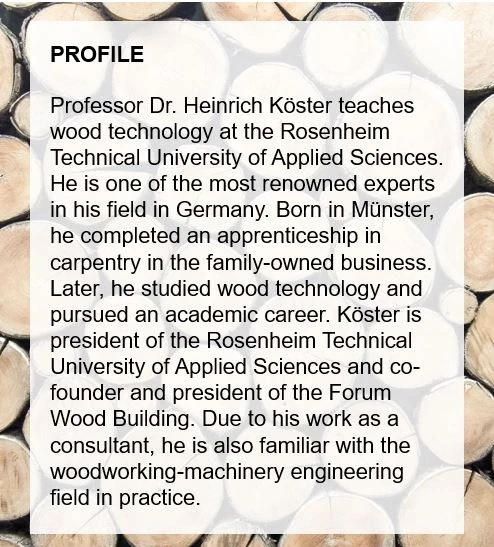
Construction material with a promising future
Wood as a natural resource offers enormous potential. That is the view of Heinrich Köster, Professor of Wood Technology and Construction at the Rosenheim Technical University of Applied Sciences. One important reason: Modern machines and plants are causing production costs to drop. A guest contribution.
Wood is the construction material with a promising future. This fact is not only reflected in the growing interest of students and mechanical engineers. The trend has long since arrived at the construction sites as well. One in five single-family homes and duplexes in Germany is now built using timber construction. It is estimated that in five years, it could be one in two.
One reason for this increase is growing environmental awareness. In fact, wood from sustainable forestry serves as an excellent means of storing CO2. This is in stark contrast to cement, the production of which releases a large amount of greenhouse gas. Good timber lasts for centuries and is excellently suited for recycling.
But there are also other good reasons for building with timber. Despite its low weight, it has an extremely high load-bearing capacity. Wood provides for a good indoor climate and protects against the cold. A 20-centimeter-thick prefabricated wooden wall filled with insulation material insulates just as well as a concrete wall five times as thick.
One in five single-family homes and duplexes in Germany is built using timber construction today.
Timber construction is also attractive from a cost perspective. Wood is easy to work with and can be processed with utmost precision. That is why this building material is particularly suited for producing large quantities of prefabricated elements in factories. Thus, high-quality residential space can be built at reasonable prices.
Mechanical and plant engineering plays a key role in driving the trend towards timber construction. Companies rely on innovative solutions to construct buildings quickly and economically with prefabricated elements. With technology from companies such as the HOMAG subsidiary Weinmann, it is already possible to produce the walls and roof of an entire house in a single day. Whereas on a construction site, it often takes a year before even the shell of the building, made of cement and bricks, is finished – with considerably higher personnel costs!
The advancing digitalization of machinery and equipment will make timber construction with prefabricated modules even more efficient and cost-effective. It therefore offers the opportunity to provide homes and offices in sufficient quantities in a sustainable and cost-effective manner in the rapidly growing metropolitan areas around the world.

